| December 12, 2007

[NIST Tech Beat Search] [Credits] [NIST Tech Beat Archives] [Media Contacts] [Subscription Information]

NIST Encasement Now Protecting ‘America’s Birth Certificate’
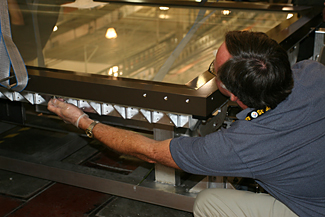 |
NIST technician Dana Strawbridge bolts the top frame of the map encasement to its base during a test sealing of the encasement prior to shipping to the Library of Congress.
Credit: NIST
View hi-resolution image |
A hermetically sealed glass and aluminum encasement built by the National Institute of Standards and Technology (NIST) will protect the first world map to label the lands of the New World as “America” when the “Exploring the Early Americas” exhibition opens Dec. 13, 2007, at the Library of Congress (LOC) in Washington, D.C. The 40-square-foot, state-of-the-art display case is the new home for the 1507 Waldseemüller map, often called “America’s birth certificate.”
Protecting America’s historic documents is not a new task for NIST. Twice before (1951 and 2003), the agency built encasements for the nation’s Charters of Freedom—the Declaration of Independence, the Constitution and the Bill of Rights—housed at the National Archives. However the Waldseemüller map encasement, developed in partnership with the LOC, is six times larger than any of those cases. The new encasement’s frame and base were machined from two solid pieces of aluminum donated by the Alcoa Company. It was sealed with a double sheet of thick, non-reflective laminated glass. The case includes valves for flushing out oxygen (which would chemically react and degrade the map’s paper and ink) and replacing it with inert argon gas. It also includes sensitive monitoring devices to constantly measure internal environmental conditions.
During the manufacturing process, NIST specialists checked the strength of the glass to ensure it would not break during barometric or temperature changes and leak-tested the encasement to certify it would keep oxygen out for at least 20 years. NIST engineers also designed devices for raising and lowering the encasement for maintenance and display.
All of the components were shipped last month to the LOC where they were reassembled prior to the Waldseemüller map’s encasement.
Dianne van der Reyden, LOC director for preservation, accepted the finished device, saying, “When it became time for us to design a case for our new national treasure, NIST was the obvious choice. We have a lot of respect for their engineers and their ingenuity, and we knew that they would be able to get this job done and get it done in time.”
Mark E. Luce, leader of the 11-member NIST encasement team, said, “We at NIST are proud to have had the opportunity to use the skills we use everyday to make world class, unique instruments to preserve ’the birth certificate of America.’”
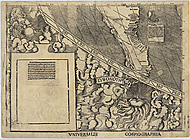 This sheet from the lower left corner of the 12 that make up the Library of Congress Waldseemüller map marks the first time the word "America" was used for the newly discovered lands.
Credit: Library of Congress
View hi-resolution image |
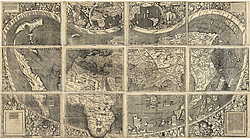 This map shows the outline of North and South America, as well as the Isthmus of Panama, and was the first to depict clearly a separate Western Hemisphere, with the Pacific as a separate ocean.
Credit: Library of Congress
View hi-resolution image |
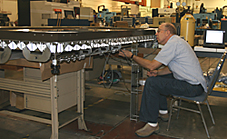
Retired NIST physicist Charles Tilford, a consultant to the Library of Congress, attaches apparatus to replace air in the encasement with inert argon gas to help preserve the map.
Credit: NIST
View hi-resolution image |
For more information on the Waldseemüller map and its new NIST-designed and manufactured home, see:
Editor’s Note: B-roll video of these processes is available for the broadcast media.
Media Contact: John Blair, john.blair@nist.gov, (301) 975-4261 

NIST Imaging System Maps Nanomechanical Properties
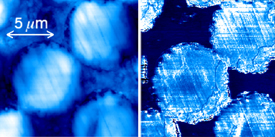 |
An atomic force microscope normally reveals the topography of a composite material (l.) NIST's new apparatus adds software and electronics to map nanomechanical properties (r.) The NIST system reveals that the glass fibers are stiffer than the surrounding polymer matrix but sometimes soften at their cores.
Credit: DC Hurley/NIST
View higher resolution image |
The National Institute of Standards and Technology (NIST) has developed an imaging system that quickly maps the mechanical properties of materials—how stiff or stretchy they are, for example—at scales on the order of billionths of a meter. The new tool can be a cost-effective way to design and characterize mixed nanoscale materials such as composites or thin-film structures.
The NIST nanomechanical mapper uses custom software and electronics to process data acquired by a conventional atomic force microscope (AFM), transforming the microscope’s normal topographical maps of surfaces into precise two-dimensional representations of mechanical properties near the surface. The images enable scientists to see variations in elasticity, adhesion or friction, which may vary in different materials even after they are mixed together. The NIST system, described fully for the first time in a new paper,* can make an image in minutes whereas competing systems might take an entire day.
The images are based on measurements and interpretations of changes in frequency as a vibrating AFM tip scans a surface. Such measurements have commonly been made at stationary positions, but until now 2D imaging at many points across a sample has been too slow to be practical. The NIST DSP-RTS system (for digital signal processor-based resonance tracking system) has the special feature of locking onto and tracking changes in frequency as the tip moves over a surface. Mechanical properties of a sample are deduced from calculations based on measurements of the vibrational frequencies of the AFM tip in the air and changes in frequency when the tip contacts the material surface.
NIST materials researchers have used the system to map elastic properties of thin films with finer spatial resolution than is possible with other tools. The DSP-RTS can produce a 256 × 256 pixel image with micrometer-scale dimensions in 20 to 25 minutes. The new system also is modular and offers greater flexibility than competing approaches. Adding capability to map additional materials properties can be as simple as updating the software.
* A.B. Kos and D.C. Hurley. Nanomechanical mapping with resonance tracking scanned probe microscope. Measurement Science and Technology 19 (2008) 015504.
Media Contact: Laura Ost, laura.ost@nist.gov, (303) 497-4880 

New Paper Reveals Nanoscale Details of Photolithography Process
 |
Schematic of the photolithography process shows the formation of a gradient extending from the photoresist material to be removed (center) into the unexposed portions of the resist on the sides. NIST measurements document the residual swelling fraction caused by the developer that can contribute to roughness in the final developed image.
Credit: NIST
View higher resolution image |
Scientists at the National Institute of Standards and Technology (NIST) have made the first direct measurements of the infinitesimal expansion and collapse of thin polymer films used in the manufacture of advanced semiconductor devices. It’s a matter of only a couple of nanometers, but it can be enough to affect the performance of next-generation chip manufacturing. The NIST measurements, detailed in a new paper,* offer a new insight into the complex chemistry that enables the mass production of powerful new integrated circuits.
The smallest critical features in memory or processor chips include transistor “gates.” In today’s most advanced chips, gate length is about 45 nanometers, and the industry is aiming for 32-nanometer gates. To build the nearly one billion transistors in modern microprocessors, manufacturers use photolithography, the high-tech, nanoscale version of printing technology. The semiconductor wafer is coated with a thin film of photoresist, a polymer-based formulation, and exposed with a desired pattern using masks and short wavelength light (193 nm). The light changes the solubility of the exposed portions of the resist, and a developer fluid is used to wash the resist away, leaving the pattern which is used for further processing.
Exactly what happens at the interface between the exposed and unexposed photoresist has become an important issue for the design of 32-nanometer processes. Most of the exposed areas of the photoresist swell slightly and dissolve away when washed with the developer. However this swelling can induce the polymer formulation to separate (like oil and water) and alter the unexposed portions of the resist at the edges of the pattern, roughening the edge. For a 32-nanometer feature, manufacturers want to hold this roughness to at most about two or three nanometers.
Industry models of the process have assumed a fairly simple relationship in which edge roughness in the exposed “latent” image in the photoresist transfers directly to the developed pattern, but the NIST measurements reveal a much more complicated process. By substituting deuterium-based heavy water in the chemistry, the NIST team was able to use neutrons to observe the entire process at a nanometer scale. They found that at the edges of exposed areas the photoresist components interact to allow the developer to penetrate several nanometers into the unexposed resist. This interface region swells up and remains swollen during the rinsing process, collapsing when the surface is dried. The magnitude of the swelling is significantly larger than the molecules in the resist, and the end effect can limit the ability of the photoresist to achieve the needed edge resolution. On the plus side, say the researchers, their measurements give new insight into how the resist chemistry could be modified to control the swelling to optimal levels.
The research, funded by SEMATECH, is part of a NIST-industry effort to better understand the complex chemistry of photoresists in order to meet the needs of next-generation photolithography.
* V.M. Prabhu, B.D. Vogt, S. Kang , A. Rao , E.K. Lin and S.K. Satija. Direct measurement of the spatial extent of the in situ developed latent image by neutron reflectivity. Journal of Vacuum Science and Technology B, 25(6), 2514-2520 (2007).
Edited to update publication citation, Wednesday, December 12, 2007 1:36 PM.
Media Contact: Michael Baum, michael.baum@nist.gov, (301) 975-2763 

NIST Helps Beam Time to TV Viewers in the Middle East
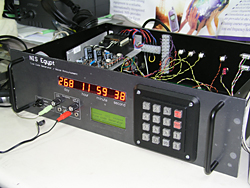 |
This time code generator, built by NIST staff, contains custom electronics that keep track of the time of day, sychronized with audio recordings. The signals are sent to satellites, which transmit the time to millions of homes in North Africa and the Middle East. (Click image for an mp3 recording of this announcement in Arabic: "At the sound of the tone, the time will be 1 hour, 7 minutes, Egyptian Standard Time.")
Credit: NIST
View hi-resolution image |
Millions of satellite television and radio users in North Africa and the Middle East can now see and hear the precise time of day, thanks to technical assistance and a custom-built time signal generator from the National Institute of Standards and Technology (NIST).
The new system, which began broadcasting time data and audio reports this year,* is the most widely available source of atomic time in the region. Previously, smaller numbers of users have had access to an automated computer time service (also designed by NIST) and the Global Positioning System, a military satellite service that provides time signals to civilian users with GPS receivers. Now, users of commercially available satellite dishes and receivers can get atomic time by decoding a standard time code format or listening to the audio broadcast.
NIST provided assistance to the National Institute for Standards in Egypt, which negotiated for a special channel for the new service from the Egyptian Satellite Company (NILESAT). NIST built the time code generator, about the size of a briefcase, which produces two signals, a standard time code and an audible seconds pulse and top-of-the-minute voice announcement in Arabic. The time code includes Daylight Saving Time corrections as well as leap year and leap second warnings. NIST and Egyptian standards officials recorded the voices (“At the sound of the tone, the time will be [hour and minute] Egyptian Local Time.”).
The NIST device, installed at a satellite uplink facility in 6th of October City, Egypt, synchronizes its reports with a cesium atomic clock at the same location that is itself synchronized with Coordinated Universal Time to provide traceability to international time standards. According to John Lowe of NIST, Egyptian officials also plan to use the new service to mount time displays in public places. The project was funded by a grant from the U.S.-Egypt Joint Science and Technology Program.
* J. Lowe, J. Heidecker, M.A. Swidan, A. Hisham and S. Samuel. Standard time and frequency dissemination via Egyptian digital satellite. Presented at 39th Annual Precise Time and Time Interval Systems and Applications Meeting, Long Beach, Calif., Nov. 26-29, 2007.
Media Contact: Laura Ost, laura.ost@nist.gov, (303) 497-4880 

‘Combinatorial’ Approach Squashes Software Bugs Faster, Cheaper
A team of computer scientists and mathematicians from the National Institute of Standards and Technology (NIST) and the University of Texas, Arlington is developing an open-source tool that catches programming errors by using an emerging approach called “combinatorial testing.” The NIST-Texas tool, described at a recent conference,* could save software developers significant time and money when it is released next year.
Studying software crashes in a variety of applications from medical devices to Web browsers, NIST researchers obtained hard evidence to support long-held conventional wisdom: most software failures result from simple events rather than complex ones.** Even for Web browsers containing hundreds of different variables, most failures were caused by interactions between just two variables. Nonetheless, in the applications that the researchers studied, additional failures could result from interactions of up to six variables.
Based on that insight, the NIST-Texas team went beyond the popular practice of “pairwise testing,” or exploring interactions between only two variables at a time, and designed a method for efficiently testing different combinations of settings in up to at least six interacting variables at a time. Their technique resembles combinatorial chemistry in which scientists screen multiple chemical compounds simultaneously rather than one at a time.
For example, imagine a word-processing program that features 10 different text formats. Certain combinations of settings (such as turning on superscript, subscript and italics at the same time) could cause the software to crash. Trying all possible combinations of the 10 effects together would require 1,024 tests. However, testing all possible combinations of any three effects requires just 13 different tests, thanks in part to the fact that if the tests are selected judiciously the 10 different variables allow you to explore 120 combinations of “triples” simultaneously.
The new tool generates tests for exploring interactions among the settings of multiple variables in a given program. Compared to most earlier combinatorial testing software, which has typically focused on testing interactions between just two variables, the tool excels at quickly generating efficient tests for 6-way interactions or more.
The researchers plan to release the tool early next year as open-source code. They currently are inviting developers to participate in beta testing of the tool before release. This new approach for finding bugs to squash may be particularly useful for increasing the reliability of e-commerce Web sites, which often contain many interacting variables, as well as industrial process controls, such as for robotic assembly lines of high-definition televisions, which contain many interacting software-controlled elements that regularly turn on and off.
* Y. Lei, R. Kacker, D. R. Kuhn, V. Okun and J. Lawrence, IPOG: A general strategy for t-way software testing. IEEE International Conference on Engineering of Computer-Based Systems March 26-29, 2007, pp 549-556, Tucson AZ, USA.
** D.R. Kuhn, D.R. Wallace and A.J. Gallo, Jr. Software fault interactions and implications for software testing. IEEE Trans. on Software Engineering, June 2004 (Vol. 30, No. 6) pp. 418-421.
Media Contact: Ben Stein, bstein@nist.gov, (301) 975-3097 

New Accreditation Program for Body Armor Testing Laboratories
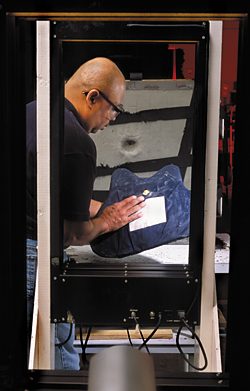 |
NIST engineering technician Nathaniel Waters examines a bullet-resistant vest being tested. With funding from the National Institute of Justice, NIST's Office of Law Enforcement Standards develops test methods and standards for the performance of equipment used by police, corrections officers and first responders.
© Robert Rathe
For a high-resolution version of this image contact inquiries@nist.gov. |
The National Institute of Standards and Technology (NIST), in cooperation with the National Institute of Justice (NIJ), has established a new accreditation program for laboratories that test personal body armor. The deadline for inclusion in the first group of candidates for accreditation is Dec. 15, 2007.
Personal body armor can mean the difference between life and death for law enforcement officers who routinely put themselves at risk to protect the public. The NIJ reports that more than 3,000 officers’ lives have been saved by personal body armor since standards were first introduced for ballistic resistance in 1972. It is imperative that the body armor that law enforcement agencies use meet meaningful minimum performance requirements, and demonstrating that requires thorough testing at reliable testing facilities.
As part of the National Voluntary Laboratory Accreditation Program (NVLAP), the new NIST program will ensure that an accredited laboratory performing tests on personal body armor is capable of obtaining reliable data and competently conducts testing in the manner described in the draft standard NIJ-0101.06: Ballistic Resistance of Body Armor. NIST made technical recommendations to the draft standard at the request of the NIJ, which is the research, development and evaluation agency of the U.S. Department of Justice.
The minimum performance requirements defined by the standards are reevaluated and updated periodically as new safety issues arise and new discoveries are made. The new draft standard is the latest recommendation following the release of interim requirements in 2005 after it was revealed that some models of body armor found to comply with the previous standard saw a significant reduction in efficacy once placed into field service. The new standards take these concerns and others into account, and the accreditation program NIST is implementing has been designed to make sure that those standards are being met when the next generation of armors is tested.
Laboratories wishing to be accredited must submit an application and pay required fees. Applications received after Dec. 15, 2007, will be considered in the order they are received. Successful applications are contingent upon the completion of the application process, which includes an assay of the operation by technical experts and demonstrated proficiency of personnel.
Laboratories may obtain NIST Handbook 150, NVLAP Procedures and General Requirements, NIST Handbook 150-24, Personal Body Armor, and an application for accreditation for this program by calling (301) 975-4016, by writing to NVLAP Body Armor Testing Program Manager, National Voluntary Laboratory Accreditation Program, 100 Bureau Drive/MS 2140, Gaithersburg, MD 20899-2140, or by sending e-mail to nvlap@nist.gov. All applications for accreditation must be submitted to: NVLAP/Accounts, National Institute of Standards and Technology, Building 101, Room A800, 100 Bureau Drive/MS 1624, Gaithersburg, MD 20899-1624.
Edited Thursday, December 13, 2007 1:38 PM to add photo and caption.
Media Contact: Mark Esser, mark.esser@nist.gov, (301) 975-2767 

|

